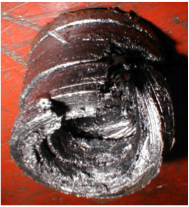Do end-users really care about fugitive emission, or do they only want cheaper valves? Part 3
Do end-users really care about fugitive emission, or do they only want cheaper valves? Part 3
So what about high density die formed graphite packings? To answer that, we have to take a look back into the last part of this article. The main issue to get a good seal is contact between the packings and the spindle/ bonnet before the compression of the packing rings starts. This is more important with high-density rings since they have a lower compression grade (10-12%). There is another element besides the packing rings that have to be addressed, and that is the shape, dimensions and the tolerances of the spindle and packing groove in valve bonnet. If we look at fig. 12 witch is a graph from one packing manufacturer.
That graph tells us some important details: The surface finish on the stem, should be Ra ≤ 0,5mm and the surface finish in the groove should be Ra ≤ 2,0mm. Understandable because the stem is a dynamic seal, and the wall of the groove is stationary seal. We don’t want a coarse stem that tears away the packing material when operated. The depth of the groove L is approx. five times S, witch is the cross-section of the packing. Then one very important small detail: The distance between the stem /bonnet and stem /packing compression ring, indicated with two red arrows are not to be more then 0,03 millimetre times S (cross-section of the packing). This is extremely important when dealing with high density Grafoil rings. If the distance between stem and the packing compression ring are to large, you may end up with packing extruded by the system pressure as shown in fig. 13 and 14.
Both packings used are high density Grafoil rings in high pressure gas applications. Both valves had a clearing between spindle and the packing compression ring that was way to large. Both cases lead to major gas leaks and total shut down of the plants. These are only two examples of a situation that unfortunately not are totally uncommon. This was major gas leaks, not fugitive emission, you can say. But there is a link here, a link between tolerances, packing material, packing treatment and small or lager leaks.
If we all care about fugitive emission in gate-globe valves, we have to look into the so-called stuffing box. How come that flanges are specified with regards to all dimensions, whether it is a raised face or a ring joint connection. The ID, OD and depth of the groove, the ring or the dimensions of the raised face area are all specified. The bolthole diameter of the flanges, the torque of the bolts connecting flanges, the length of the valves. It is all specified and the valve producer must deliver the product in accordance with those specifications. But, what about the most important seal on the valves? The dynamic seal, that seals between the stem and the bonnet. Are there any specifications with regards to dimensions, tolerances, and surface finish on the stem or in the groove. How deep should the packing goove be. At witch dimension should the valve be equipped with Chevron rings and not with graphite packings. To day it is all up to the valve manufacturer to produce some kind of a stuffing box, with the number of ring they decide, it can be from 5 to 14 rings (witch is the larges number I have found in a 4” class 1500 wedge gate valve). The valve manufacturer can use the quality of packing material they choose, if not otherwise specified from the end user! To day it is all up to the end user to specify and control that there own specifications are followed. What impact would an international specification with tolerances on the valve´s spindle area have on the price of the valve? I don’t have to answer that question. I will leave that to the readers, and ask once more: Do end-users really care about fugitive emission, or do they only want cheaper valves?
To be continued in next issue.



